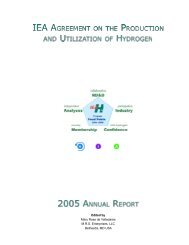Technology Status of Hydrogen Road Vehicles
Technology Status of Hydrogen Road Vehicles
Technology Status of Hydrogen Road Vehicles
Create successful ePaper yourself
Turn your PDF publications into a flip-book with our unique Google optimized e-Paper software.
The optimization <strong>of</strong> an FC has to proceed hand-in-hand with the system that transfers the FC power to the road<br />
wheels safely, economically, and reliably, and <strong>of</strong> course provide the usual driver comforts and satisfaction with<br />
no adverse environmental impact.<br />
The FC stack will consist <strong>of</strong> a number <strong>of</strong> cells to give a compact unit, easy to accommodate in the available<br />
spaces, yet not too big to discourage stack substitution if one or more cells develop problems. The number<br />
<strong>of</strong> stacks will depend on the power requirements, which depend not only on the type <strong>of</strong> vehicle and loads, but<br />
on the drive system, which can be FC-only (to meet all power demands) or FC in hybrid coupling with storage<br />
devices such as batteries (allowing FC power to be more than halved). Not surprisingly, many projects are<br />
choosing the hybrid route.<br />
The literature reveals little about stack components and performance. Besides the membrane, which is the<br />
main proprietary item, the quantities and disposition <strong>of</strong> catalysts, the electrode characteristics, and so on are<br />
confidential--a good sign <strong>of</strong> competition. Some academic sources (Anand et al. 1994; Lamy and Leger 1994)<br />
have compared membrane performance in terms <strong>of</strong> voltage/current density, but developments underway can<br />
easily change the results. New suppliers are obviously entering the field, a trend which could well continue.<br />
The hydrogen supply is another major system choice to be optimized with the fuel stack. If pure hydrogen<br />
is the choice, either as LH 2 or GH 2 or MH, it can be regarded as an independent variable with little influence<br />
on FC performance. Certainly it is less than for the ICE whose performance, as illustrated in Appendix 2, can<br />
be significantly influenced by cryogenic temperatures. The hydrogen storage, refilling, and safety questions<br />
are otherwise similar to ICE situations.<br />
For whatever reason, more attention is being given to methanol as a hydrogen-rich storage medium with FCs<br />
than with ICEs. After reforming, which needs significant heat input (at least 15% <strong>of</strong> FC power), the hydrogen<br />
is fed to scrubbers where the CO and other impurities are removed; CO is particularly poisonous at the anode<br />
(













